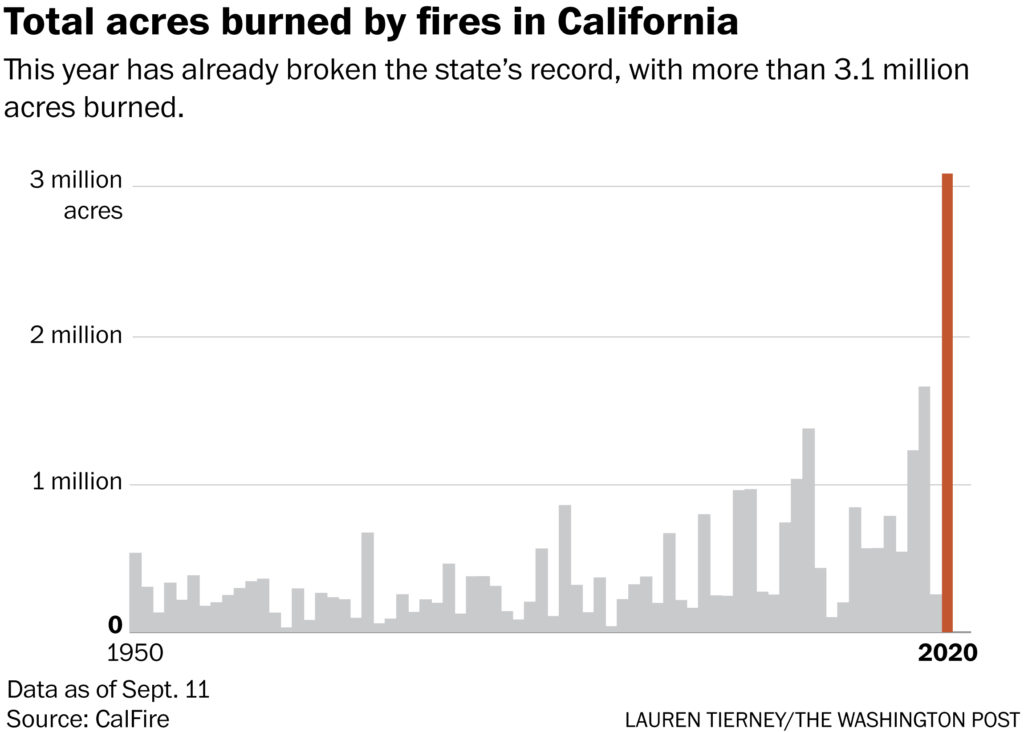How our global climate crisis is fueling rampant fires on the West Coast
The fiery image of a blazing red sky has made headlines even amidst the COVID-19 pandemic. Scientists say that the usual suspect, climate change, is responsible for this unruly disaster: it provides forest fires an ideal environment to ignite and thrive in (3).

These roaring fires not only devastate countless flora and fauna, but also threaten human lives across the West Coast. This year’s forest fires have displaced people from their homes, caused 42 deaths in California and Oregon alone, and destroyed various properties, from houses to schools (5). Over five million acres of land have burned, and the destruction only continues to proliferate (3). The impact extends past the ground level damage: thick smoke produced by the fires is heavily polluting the air, passing contamination levels in China and India’s densely populated cities (5). Although previous years have brought relentless forest fire seasons, 2020 has seen unprecedented levels of fire pollution along with health hazards.
To understand the factors that have contributed to this staggering season of fires, we must first establish the components that initially create the spark. The overall presence of fires depends on three main factors: a suitable climate, burnable materials, and an ignitor. As for environmental conditions, climate change has caused record-breaking heat waves along with low precipitation and especially strong winds. This year’s spring began earlier than in previous years, adding to the possibility of premature heat waves. California’s average temperatures have increased by about three degrees Fahrenheit since the late 1800s (3). Although a few degrees may not initially seem like a significant difference, changes in temperature exponentially affect the vapor content of air. A rising vapor pressure deficit then further dries out vegetation by allowing the plant’s humidity to transfer into the air (5). The abundance of dry and flammable material creates the perfect conditions to instigate these lengthening seasons of uncontrollable and sustained fires.

The historical control of forest fires also contributes to the magnitude of today’s fires. A period of a few decades before 1980 effectively prevented large scale fires through increased expenditure in fire-safe infrastructure, but also caused a build-up of burnable materials (5). Not only do annual fires burn up dry grasses and timber from the past year, but the wealth of past matter also feeds these mass disasters.
While to those on the North Coast of the United States the forest fires may come across as just another news article with vibrant images, the reality is miles and miles of extremely dangerous smoke and fire that plows through land and people. Without a call to action to control the impact of climate change, forest fire seasons will continue to become even longer, more uncontrollable, and demolish record-breaking acres of land.
– Connie Yang
References
- C. (2020, September 14). Wildfires and Climate Change. Retrieved October 12, 2020, from https://www.c2es.org/content/wildfires-and-climate-change/
- T. (2020, September 08). The Climate Connection to California’s Wildfires. Retrieved October 13, 2020, from https://www.nytimes.com/2020/09/08/climate/california-wildfires-climate.html
- Borunda, A. (2020, September 18). The science connecting wildfires to climate change. Retrieved October 13, 2020, from https://www.nationalgeographic.com/science/2020/09/climate-change-increases-risk-fires-western-us/
- Garcia-Navarro, L. (2020, September 13). Climate Change’s Effect On The Wildfires In The West Coast. Retrieved October 13, 2020, from https://www.npr.org/2020/09/13/912424792/climate-changes-affect-on-the-wildfires-in-the-west-coast
- Garcia-Navarro, L. (2020, September 13). Climate Change’s Effect On The Wildfires In The West Coast. Retrieved October 13, 2020, from https://www.washingtonpost.com/weather/2020/09/11/western-wildfires-climate-change/
- Team, D. (2020, September 18). California and Oregon 2020 wildfires in maps, graphics and images. Retrieved October 13, 2020, from https://www.bbc.com/news/world-us-canada-54180049
Images
- https://static01.nyt.com/images/2020/09/08/science/08CLI-CALFIRES-update/merlin_176700381_709524cd-fbfe-499c-af77-596f80821067-jumbo.jpg
- https://www.washingtonpost.com/wp-apps/imrs.php?src=https://arc-anglerfish-washpost-prod-washpost.s3.amazonaws.com/public/I5DU2DWWBRHVPHSSKWN2XUOO4A.jpg
